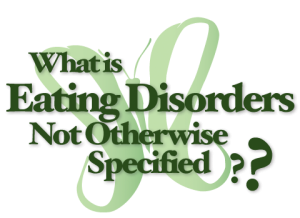 In the medical profession, we use a term ‘Eating Disorders Not Otherwise Specified’ (EDNOS) as a catchall for anyone who displays eating disorder like symptoms or thought patterns but who doesn’t meet the diagnostic criteria for the major disorders Anorexia, Bulimia or Binge Eating Disorder.
In the medical profession, we use a term ‘Eating Disorders Not Otherwise Specified’ (EDNOS) as a catchall for anyone who displays eating disorder like symptoms or thought patterns but who doesn’t meet the diagnostic criteria for the major disorders Anorexia, Bulimia or Binge Eating Disorder.
Not all eating disorders sufferers fit neatly into categories
It’s important to understand that not everyone who is suffering from an eating disorder will display the classic symptoms of the three major eating disorders. They may suffer from multiple disorders or from a form of a condition which is not extreme enough to warrant a diagnosis – but that doesn’t mean they don’t need help and support.
Eating Disorder Continuum
You can think of eating disorders as a continuum – where the more extreme cases tend to be very easy to categorise as they are more likely to tick off the various diagnostic criteria whereas people who have a less severe form of the illness or whose illness is new and progressing may not meet the criteria needed for a formal diagnosis. The medical profession requires the crude measuring stick of diagnostic criteria with people either fitting, or failing to fit the pigeon hole. However, it’s quite clear that many people who do not meet the criteria to be diagnosed with anorexia, bulimia or binge eating disorder are indeed suffering from a form of eating disorder. So these people get labelled with the term EDNOS
Young people and boys don’t always fulfil diagnostic criteria
Young people, in particular don’t always fulfil the diagnostic criteria for eating disorders. In particular for anorexia which requires a cessation of menstrual periods and a body mass index of below 17.5 (I will explain more about BMI in a later post – in short, it is a standardised number which helps us understand how over or underweight a person is based on their weight and height). Younger girls may not have even started their periods yet – so they cannot stop. And young people’s height to weight ratio (BMI) is not comparable to an adult’s, so this diagnostic criteria is not always fulfilled by younger people either. The diagnostic criteria for Anorexia are based on females and often boys, and men will not fulfil the criteria despite being very unwell with anorexic like symptoms. They may, therefore, be given a diagnosis of EDNOS.
A little bit of everything
Some people are given a label of EDNOS because they do not fit into one eating disorder category. They may display anorexic like symptoms at some points, and bulimic, or binge eating like symptoms at other points. This is quite common as many sufferers will aim for anorexic ideals and perhaps succeed for hours, days or weeks at a time, before ‘slipping up’ and spiralling into a food binge and a consequent cycle of binging and purging. Some patients who display symptoms of multiple disorders will be diagnosed with the predominant condition, whilst others will be diagnosed with EDNOS.
Eating disorders take many forms
The take home point is that eating disorders take many forms with a wide range of severity. Throughout this blog, when I use the term ‘eating disorder’ I’ll be referring to someone who has shape and weight concerns and uses food as a coping mechanism regardless of whether they are unwell enough to warrant a formal diagnosis of any type. We should be aiming to identify, help and support any young person who has emotional difficulties which are reflected in their relationship with food.
It’s important that we cast the net broadly because the earlier a problem is identified, the more likely we are to be able to provide enough support to ensure a full recovery. So whilst it’s important to understand the different forms eating disorders can take, I would suggest you forget about the labels and realise that anyone who is suffering from an eating disorder, or eating disorder like tendencies, is essentially battling with a similar problem and you are in a great position to offer help and support.

